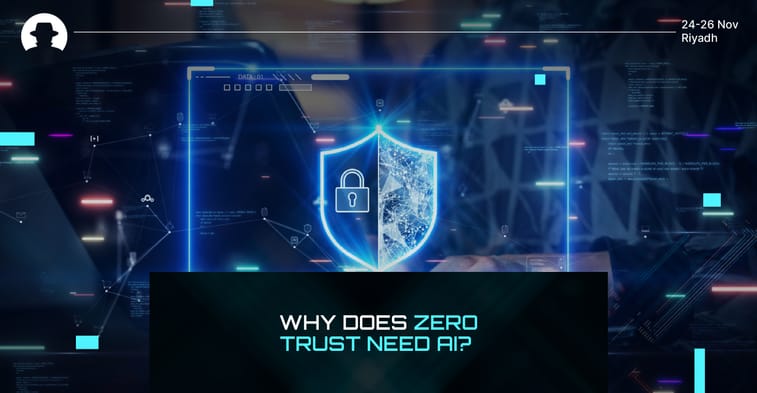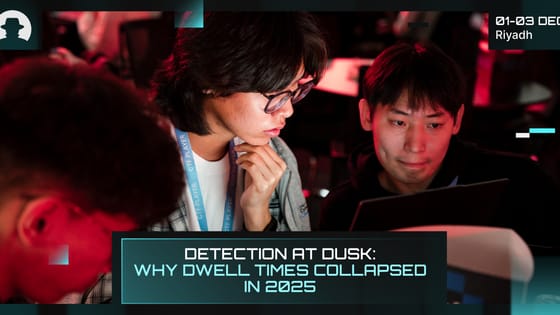
Five times BHMEA speakers surprised us in 2025
Five standout quotes from Black Hat MEA speakers in 2025, and what they reveal about cybersecurity’s year ahead.
Read More
Cyber threats are evolving at a breakneck pace, and traditional security models just aren’t cutting it anymore. Today, cybersecurity leaders are working to combine Zero Trust and AI – integrating a powerful strategy with powerful tech, to boost cyber resilience.
If you haven’t already started looking at how machine learning can strengthen your defenses, then the time is now.
A Zero Trust model treats everything as a potential threat – so you never assume that anything inside your network is safe. Every user, device, and connection has to prove itself before getting in.
And Zero Trust works. But in practice, managing it manually is a challenge that many organisations struggle to overcome.
Enter: Machine learning.
Machine learning models can analyse behaviour, detect anomalies, and automate security decisions with accuracy and speed that we humans can’t achieve manually. Instead of reacting to threats after the fact, AI helps security teams predict and prevent attacks before they happen.
Companies across industries are already leveraging AI technology to streamline their Zero Trust strategy. Zscaler is a good example of this – with a Zero Trust Exchange platform that uses AI to make sure users connect securely to apps, without exposure to unnecessary risks.
Then there’s Deep Instinct, a deep learning-based cybersecurity framework which uses deep learning algorithms that can predict and block threats before they execute. And if you’re looking for managed security services, LevelBlue (formerly AT&T Cybersecurity) is integrating AI into its Zero Trust solutions to provide real-time monitoring and rapid response.
These are just a few of many security innovators that have recognised the value of AI to enable efficient, effective Zero Trust frameworks. Because ultimately, if the implementation isn’t there, then Zero Trust is just a concept; an ideal world that’s just a little out of reach.
Cybersecurity is a complex field. And while AI has clear use cases to change things for the better, we know it comes with its own challenges. Data privacy is a serious concern for any organisation leveraging AI models. They need vast volumes of data to be effective, but that raises concerns about how that data is collected, stored, and used. Countries around the world continue to establish and fine-tune regulations to make sure organisations (including AI developers) treat data responsibly, but we’re still a long way from watertight regulatory controls.
Linked to this is the issue of trust when it comes to the data that AI uses. While AI is helping to enforce Zero Trust policies, the AI itself needs to be trustworthy. That means it has to be transparent, explainable, and free from biases. If a security system is making automatic decisions about threats, IT teams need to understand what those decisions are based on – and we need systems in place to evaluate and flag potential problems in both data and decision-making on an ongoing basis.
And in any conversation about the risks of AI in cybersecurity, we have to acknowledge adversarial AI. Hackers are using machine learning too, and they’re getting better all the time at tricking AI models into making the wrong calls. This is an ongoing battle – one that requires constant updates and improvements to keep AI-driven security systems ahead of attackers.
The future of cybersecurity is heading straight into the AI-powered Zero Trust era. Even governments are getting on board. A recent executive order in the US, for example, is pushing for AI-driven cybersecurity in federal systems.
At the same time, universities around the world are doubling down on education in AI and security, with dedicated AI research and learning courses and facilities.
In a wide range of industries, security teams need to work on integrating AI into their Zero Trust strategy. The combination of continuous authentication, automated threat detection, and predictive analytics is an essential shift to protect against threats that are getting smarter all the time.
Join us at Black Hat MEA 2025 to share your perspective and meet potential partners – and shape the future together.
Join the newsletter to receive the latest updates in your inbox.

Five standout quotes from Black Hat MEA speakers in 2025, and what they reveal about cybersecurity’s year ahead.
Read More
Dwell times collapsed in 2025, yet breaches became faster and harder to catch. Learn how attacker speed reshaped cybersecurity and what teams need for 2026.
Read More
Identity fraud in 2026 is AI-driven, industrial and costly. Learn how deepfakes, fraud rings and new cyber insurance rules are changing identity protection.
Read More